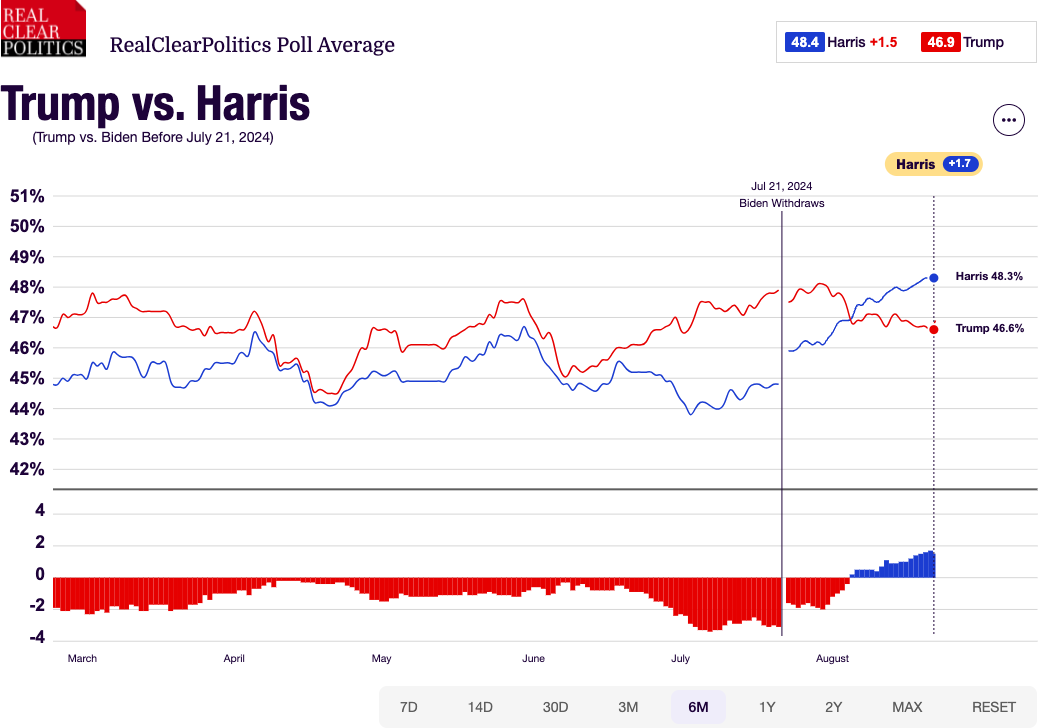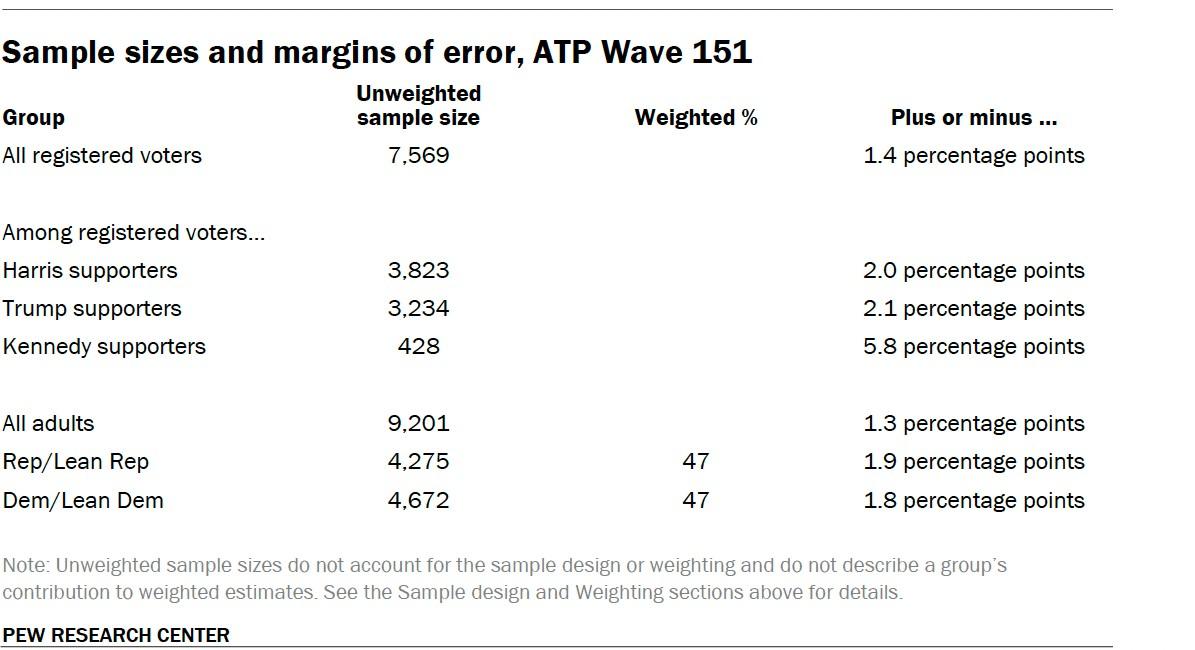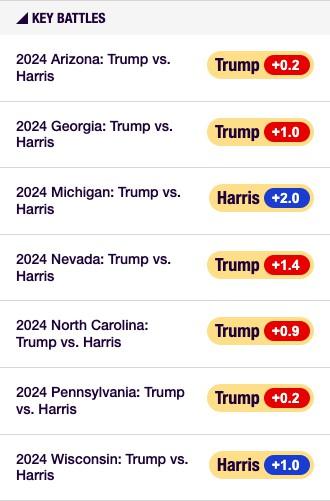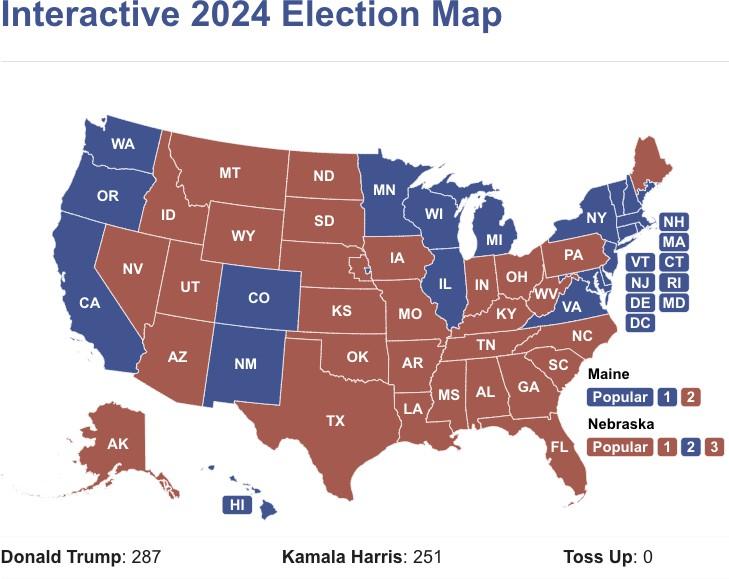A Snapshot of the US Presidential Race
We’ve just seen Kamala Harris formally accept the Democratic nomination for President, so now is a good time to vibe-check where we are in the Presidential race.
Kyle Rodda, Senior Market Analyst, Capital.com
We’ve just seen Kamala Harris formally accept the Democratic nomination for President, so now is a good time to vibe-check where we are in the Presidential race. There are still two months until the actual vote, and as we’ve experienced in the past two months, a lot can happen in that time. Nevertheless, it’s a tight race with huge market implications, so it’s helpful to refresh oneself with the current state of play. Here’s a high-level overview of what’s going on.
What are polls and betting markets saying?
Both betting markets and public polling suggest that it’s a neck-and-neck race. Real Clear Polling is a handy tool to aggregate betting markets and polling, with all the data used here derived from its website. As of the 23rd of August, betting markets have squared both candidates after a surge that saw Vice President Kamala Harris become the bookies’ favourite in the middle of August.

(Source: Real Clear Politics)
Meanwhile, the site’s polling aggregator indicates a similar trend, with Harris remaining in the lead with a healthy, although hardly overwhelming, 1.7-point advantage.
 (Source: Real Clear Politics)
(Source: Real Clear Politics)
On the surface, Harris appears to have her nose in front, with the wind at her back, given the momentum she’s built since US President Joe Biden withdrew from the race. However, digging deeper into the details, the balance of probabilities shifts and tells a slightly different story.
Trump is in a better position than the markets and polls suggest
Firstly, Democrats tend to perform better in polls than they do in elections. The primary reason is that Democrats end up overrepresented in pre-election polls. It’s a point of contention as to why the phenomenon exists. Some suggest it is socioeconomic in nature; others believe it is political psychology, with Republicans potentially less inclined to speak openly about their politics. Here is the data from a Pew Research poll – note the unweighted sample size of Harris supporters and those that identify as Democrat or lean Democrat.

It shows a far more significant proportion of Harris supporters or nominally Democrat voters. It must be said that pollsters try to re-weight the data to get a more accurate picture of preferences within the electorate. After the catastrophically inaccurate polling in 2016, they have attempted to correct for the underrepresentation of Republican voters in their polls to avoid such embarrassing surprises and misleading data. However, adjusting polling in such ways remains a dark and imperfect art. This election may be the one in which pollsters correct their errors and perfect their methodology. However, until proven otherwise, the rule of thumb is polling, at least historically, overstate Democrat popularity by anywhere between two and five points.
Secondly, looking at some of the polling for key battleground states paints a much better picture for former President Donald Trump than betting markets and preferred President polling does.
 (Source: Real Clear Politics)
(Source: Real Clear Politics)
As can be seen, out of the seven states most pollsters believe to be swing states, five sway towards Trump, while the other two lean toward Harris. So, what does this mean for electoral college votes? Using an interactive Electoral College map, we can punch in the implied result of each state based on the above polling. When we do that, we get the following breakdown.

(Source: electoralvotemap.com)
It suggests Trump is ahead. Of course, there are a few assumptions that go into this; first, we assume that every other state outside the battlegrounds vote the same way as they did in 2020 – a not unreasonable premise; second, we split Nebraska – which, with Maine, has a divergent way of allocating electoral college votes – two to one in favour of Republicans. With all of this accounted for, based on the latest battleground state polling, Donald Trump narrowly takes the White House and wins a second term.
There are several permutations where one state or another swings in a different direction, which could influence the result. However, the critical battleground could be Pennsylvania. Firstly, polling suggests it’s a close fight – the latest aggregate gives Trump a slim 0.2-point advantage. Secondly, it carries the most electoral college votes of all the swing states. Finally, along with Michigan and Wisconsin, it's one of the critical rust-belt states apart of the traditional Democrat heartland, which the MAGA movement managed to turn Red in 2016 and may flip again.
When breaking down the basic arithmetic (and again assuming all else being equal), Trump winning Pennsylvania will hand him 287 electoral college votes and a modest but decisive victory. However, should Harris swing the state in her favour, she would literally win the electoral college vote by the slimmest margin: 270 to 268. This potentiality is why Harris’ pick of Timothy Walz as Vice Presidential candidate could prove so significant. In picking Walz, she overlooked Pennsylvania Governor Josh Shapiro, who would likely have provided an additional edge in the state. If the election practically comes down to Pennsylvania and Harris loses, it may be one of the big talking points of the election.
Where to from here?
Based on polling and betting markets, it would be fair to say that if the election were held today, Donald Trump would be the victor – probably while losing the popular vote. What works in Harris’ favour is she has momentum and more time to build on it; the trends in betting markets and polls may continue in the weeks and months ahead, widening her lead and maybe nudging her ahead in crucial swing states. The next significant event – assuming no other nasty surprises – will be the September 10 Presidential debate, which will mostly be a test of how well the hitherto stage-managed Kamala Harris handles the pressure. It will also provide an opportunity for Trump to reclaim the narrative and recapture the ascendency he achieved following his first debate against President Biden.